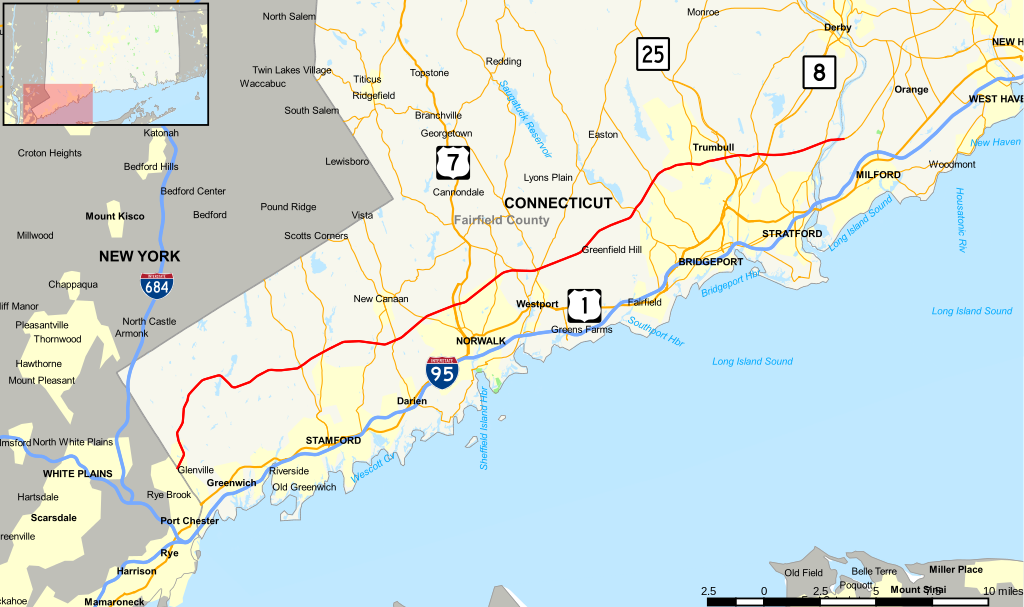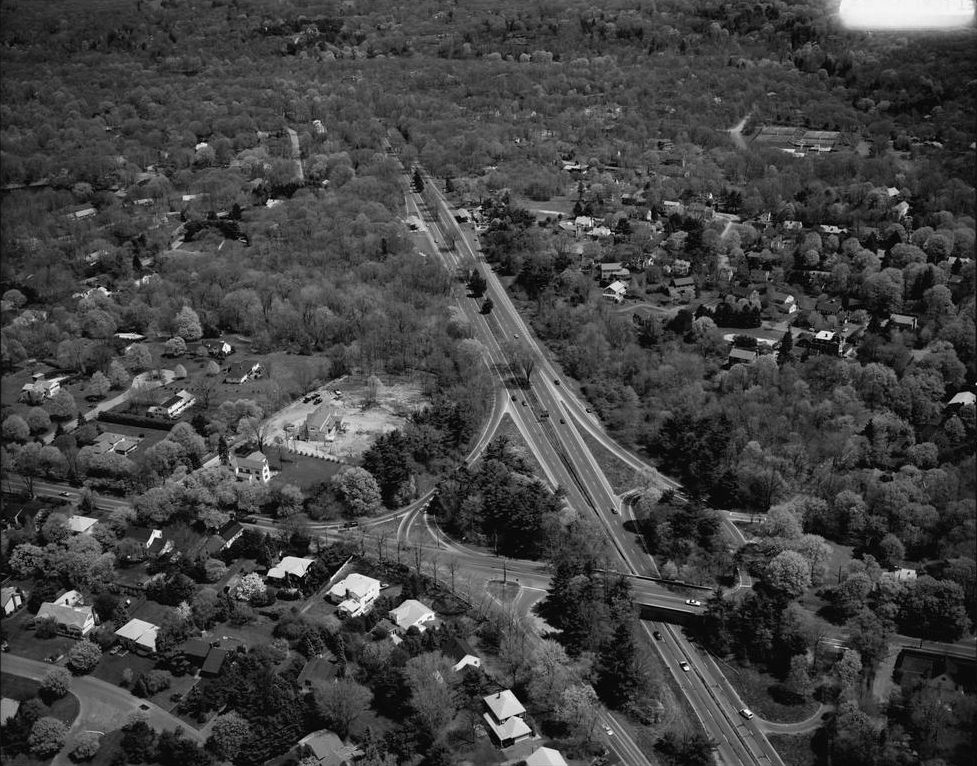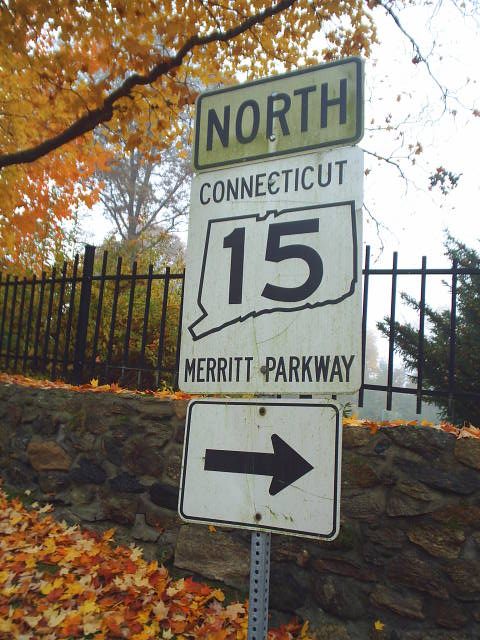The Alluring Art Deco Parkway That Winds Through Connecticut

A soothing drive down Connecticut’s Merritt Parkway. (Photo: Doug Kerr/ flickr)
If there were an EGOT for highways, Connecticut’s Merritt Parkway would surely be one.
It is listed as a National Scenic Byway by the Federal Highway Commission, which could be considered the Pulitzer Prize for public roads. The National Park Service has listed it as a Registered Historic Place (a list that includes thousands of American spaces, but only a handful of highways). The Merritt has its own conservancy, a non-profit organization dedicated solely to keeping the Merritt intact and as beautiful as possible. Even the Library of Congress has written about the Merritt’s hallowed paved roads.
It’s a truly beloved span of pavement. But why? What makes this road so interesting? The answer lies in both its history and design.
The Merritt Parkway is a four-lane highway, with a large and wooded median in between. The lanes are narrow, there are no streetlights, and it’s completely surrounded by forest. The on-ramps are almost nonexistent, meaning that getting onto the road can be a bit like the initial descent of a roller coaster. The best part, however, is that no trucks are allowed–it’s a zippy car haven. And the cars do go fast.

The Merritt Parkway runs 37 miles down the southern edge of Connecticut. (Photo: Chinissai/WikiCommons CC BY-SA 4.0)
It was built in the 1930s, as an alternate route to the Boston Post Road, the old mail route from Boston to New York City. For years the Post Road was the only way for Massachusetts, Connecticut, Rhode Island, and New York residents to travel long distances. As cars became more commonplace in the twentieth century, the Post Road became congested.
The congestion only increased with time; teenagers began joyriding and day trips to the big city were more feasible with faster cars. By the 1920s It became clear that another roadway was necessary. Questions arose about where it should be and what it should look like.
According to Jill Smyth, the executive director of the Merritt Parkway Conservancy, six different road options were considered before they decided on what became the Merritt. The idea behind the winning design was that it would be far away from the Post Road. This was primarily for economic reasons: The land needed to build the roads would be cheaper if it wasn’t close to any downtowns.

Flying above the Merritt Parkway is nowhere near as fine as driving along the highway itself. (Photo: Library of Congress)
As plans for the new road began to firm up, residents of Connecticut’s Fairfield County came together to decide on the aesthetics. The integrity of the land, they decided, needed to be kept intact. “They wanted to make sure the parkway was going to be a beautiful parkway,” said Smyth, “not a highway… a road that would highlight the beauty of Connecticut.”
The planners hired architect George Dunkelberger to design the bridges on the road. They also brought along a slew of engineers and landscape architects to make sure the parkway maintained a homogeneous and aesthetically pleasing appearance. The idea was to make a highway that was unobtrusive, as if nothing had really changed. The road was to look wooded and like a forest. If anything man-made was built, it needed to be classy.
The intentionality of the Merritt’s designers’ efforts paid off. Connecticut drivers instantly loved it and years later national organizations took notice of the highway’s uniqueness. Of the thousands of U.S. roads in existence, only about 150 have been designated as “Scenic Byways.” The Merritt is one of them.

Autumn foliage makes a drive along the Merritt even more pleasing. What are you waiting for? (Photo: Doug Kerr/flickr)
To be listed as a National Scenic Byway, the highway must be nominated. It is then judged on whether or not it has the following six qualities: scenic quality, historic quality, recreational quality, cultural quality, archeological quality, and natural quality. That is, the highway must be a stellar physical example of a roadway and have history, character, and beauty in ways most other paved streets do not. It is a rare honor for roads.
The Federal Highway Administration, which awards the designation, considered the Merritt to be of this caliber. It described the highway’s aesthetic as “Art Deco, or Art Moderne, styles of the 1920s and 1930s.” The Library of Congress piled on the Merritt adoration, calling it an “outstanding and largely intact example of the early twentieth-century parkways created as an outgrowth of the City Beautiful Movement.“

A tollbooth along the Merritt Parkway back in 1955. Oh, if only tolls were still just 20 cents. (Photo: Library of Congress)
Those who live nearby have a unique love for this beautiful road– it is a real point of pride for the area. If you ask someone from Connecticut the best way to get to New York, they’ll likely mention the Merritt and then go on to describe its narrow roads, and how stunning it is during leaf peeping season. There’s a Merritt Lobby Museum as well as one of its toll booths available to view off its exits, both of which have become popular fan attractions. There’s just something about this meandering road that piques people’s interests.
History aside, it’s really the experience of driving the Merritt that makes it so alluring. It’s enclosed and ancient, like driving through a Shire. And residents and organizations like Smyth and the Federal Highway Administration are working to keep it that way.
“Everyone loves the Merritt Parkway,” Smyth said. “They treasure it.”







Follow us on Twitter to get the latest on the world's hidden wonders.
Like us on Facebook to get the latest on the world's hidden wonders.
Follow us on Twitter Like us on Facebook